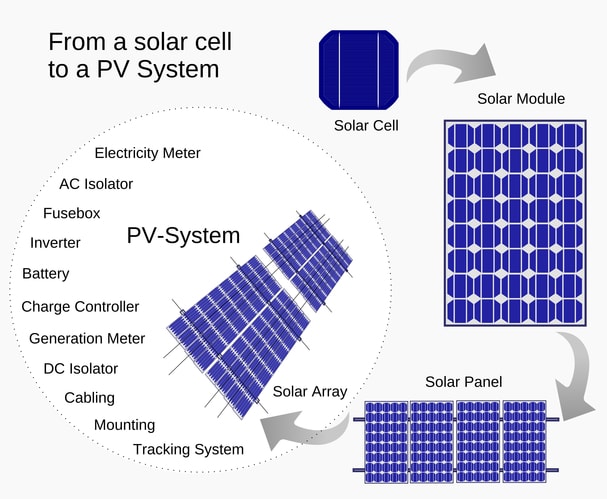Solar Panels
Inside a solar cell
First, some physics
Photovoltaic
solar panels convert light from the sun into electricity.
Note that this is different from
thermal solar where heat is converted to electricity. Therefore, the question is
how can light be converted to electricity? To understand this, let us go over some physics. All matter is
made up of atoms. These atoms in turn are made up of electrons (negatively-charged), protons
(positively-charged) and neutrons. Electricity is a flow
of electrons, jumping from one atom to another. The hard part of generating electricity is starting and
sustaining the flow. To do that, we need an electric field which you can get by separating a
positively-charged material (not enough electrons) from a negatively-charged one (too many electrons).
Connecting these two materials with a conductor allows electrons flow from the negative one to the positive
one. That flow
neutralizes the charges and kills the field unless we have a way of sustaining the charges and the fields.
Creating the field
PV panels often create the electric field in silicon. By the way, silicon is the primary
element found in sand. Yes, sand! But no, you cannot take sand
from your backyard and get electricity because the silicon has to be specially treated for the magic to
happen. Specifically, the silicon has to be "doped" with a element that can accept electrons e.g. boron at
one end
and a
element with extra electrons e.g. phosphorous at the other. When these two kinds of silicon are put
together, the extra electrons from one side rush to the other side. The loss and gain of electrons causes
one side to be positively charged and the other side negatively charged which creates the electric field
we earlier mentioned.
Making electrons flow
Once the field is created, the electron flow is started using light particles from the sun.
Yes, light has particles called photons.
These light particles are able to knock the electrons out of the silicon. The free electrons are attracted
to the positive side but this creates holes in the negative side and extra electrons on the positive side.
When both sides are connected by a
conductor, the electrons flow
from the side with extra electrons to the side with holes. Along the way, those
electrons pass through appliances like lights and television sets and do the work to power those appliances.
From cells to modules
What we have previously described happens in one solar cell. To get more power, we need more solar cells
trapping those photons and pushing those electrons along. So, manufacturers combine multiple solar cells
to form modules. Modules are then combined to form panels. Depending on the number of solar cells,
we can get panels that provide over 300W of power.
Installers like us can then combine modules to form arrays that provide kilowatts or even megawatts of power.
To put things in perspective, a 42-inch LED TV or a ceiling fan both consume less than 100W of power. A
modern large deep freezer consumes less than 250W of power.
 Image source: Solar Cell, Wikipedia
Image source: Solar Cell, Wikipedia
Efficiency
The efficiency of solar cells and panels refers to how much power can be generated from one photon of light.
And it depends on several factors including the materials used for the electric field junction mentioned
earlier as well as those used for doping. The purity of the materials used and manufacturing process is also
important. More recently, manufacturers have improved the performance of the module in the face of effects
like shading where the some section of the module is shaded leading to a significant loss of efficiency.
Solar Panels at SolarKobo
See our selection of
solar panels
at our online store. We apply our extensive knowledge of the inner workings of PV panels to ensure that
our customers in Nigeria get the most efficient and long-lasting panels at the best possible price.

 Image source: Solar Cell, Wikipedia
Image source: Solar Cell, Wikipedia